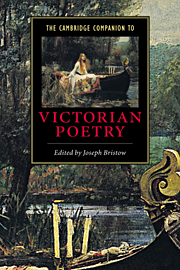Book contents
- Frontmatter
- 1 Reforming Victorian poetry: poetics after 1832
- 2 “The Lady of Shalott” and the critical fortunes of Victorian Poetry
- 3 Experimental form in Victorian poetry
- 4 The dramatic monologue
- 5 Victorian meters
- 6 Victorian poetry and historicism
- 7 Victorian poetry and science
- 8 Victorian poetry and religious diversity
- 9 The Victorian poetess
- 10 The poetry of Victorian masculinities
- 11 Aesthetic and Decadent poetry
- 12 Victorian poetry and patriotism
- 13 Voices of authority, voices of subversion: poetry in the late nineteenth century
- Glossary
- Guide to Further Reading
- Index
2 - “The Lady of Shalott” and the critical fortunes of Victorian Poetry
Published online by Cambridge University Press: 28 May 2006
- Frontmatter
- 1 Reforming Victorian poetry: poetics after 1832
- 2 “The Lady of Shalott” and the critical fortunes of Victorian Poetry
- 3 Experimental form in Victorian poetry
- 4 The dramatic monologue
- 5 Victorian meters
- 6 Victorian poetry and historicism
- 7 Victorian poetry and science
- 8 Victorian poetry and religious diversity
- 9 The Victorian poetess
- 10 The poetry of Victorian masculinities
- 11 Aesthetic and Decadent poetry
- 12 Victorian poetry and patriotism
- 13 Voices of authority, voices of subversion: poetry in the late nineteenth century
- Glossary
- Guide to Further Reading
- Index
Summary
Introduction
The standard story about the critical fortunes of Victorian poetry in the twentieth century goes like this. During the early part of the century, particularly after 1914, modernist writers like T.S. Eliot and Virginia Woolf defined themselves against the Victorians, whom they saw as old-fashioned, somewhat hypocritical, and not particularly good writers. Eliot compared Alfred Tennyson and Robert Browning unfavorably to the seventeenth-century poet John Donne, arguing that the former “are poets, and they think; but they do not feel their thought... as immediately as the odor of a rose ... A thought to Donne was an experience; it modified his sensibility.” In A Room of One's Own (1929), Woolf quoted love lyrics from Tennyson and Christina Rossetti to invoke “some feeling that one used to have (at luncheon parties before the war perhaps),” and believed this poetry was inspired by an “illusion.” “Why,” she asked, “not praise the catastrophe . . . that destroyed the illusion and put truth in its place?” “The Angel in the House,” the title of Coventry Patmore's famous mid- Victorian poem, became for Woolf the name for an oppressive Victorian model of femininity that modernist women writers needed to discard in order to write freely.
- Type
- Chapter
- Information
- The Cambridge Companion to Victorian Poetry , pp. 25 - 45Publisher: Cambridge University PressPrint publication year: 2000
- 5
- Cited by



